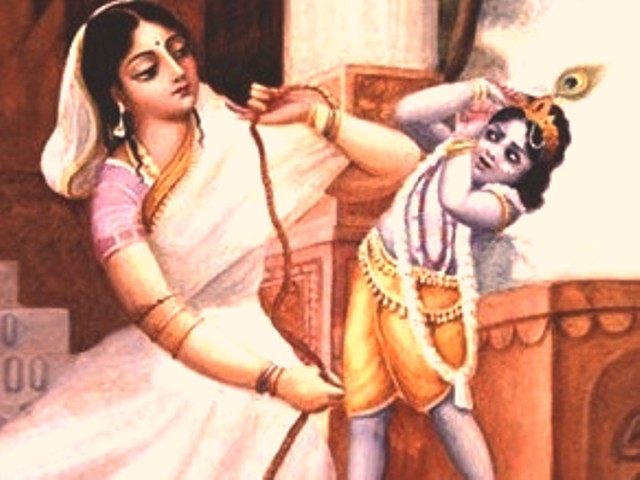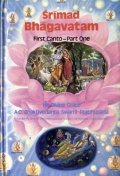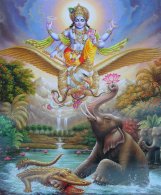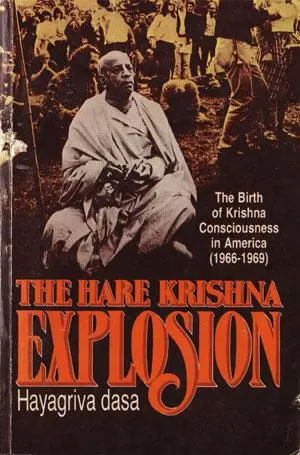12 Nov 2023
by The Hare Krishna Movement
in A. C. Bhaktivedanta Swami Prabhupada, Damodara, Kartika, Krishna, Krishna Consciousness
Purport to the Damodara Prayer which is Recited During the month of Kartika
Question: What Two Personalities Became Great Devotees of Krsna in His Damodara Lila?
Prabhupada: There is a statement in Padma Puräna describing the ritualistic function during the month of Kärttika (October-November). During this month, in Vrndävana it is the regulative principle to pray daily to Lord Krsna in His Dämodara form. The Dämodara form refers to Krsna in His childhood when He was tied up with rope by His mother, Yasodä. Däma means “ropes,” and udara means “the abdomen.” So Mother Yasodä, being very disturbed by naughty Krsna, bound Him round the abdomen with a rope, and thus Krsna is named Dämodara. During the month of Kärttika, Dämodara is prayed to as follows: “My dear Lord, You are the Lord of all, the giver of all benedictions.”
More
13 Oct 2019
by The Hare Krishna Movement
in Damodara, Kartika
Tags: ghee lamp, kartik, Krishna, month of Damodar, spiritual advancement

Kartik: Month of Prayer and Giving
Kartik, or the month of Damodar, is considered the best of months and is most auspicious for spiritual advancement. In the Skanda Purana it is stated:
“As Satya-yuga is the best of yugas, as the Vedas are the best of scriptures, as Ganga is the best of rivers, so Kartik is the best of months, the most dear to Lord Sri Krishna.”.
Also in the Skanda Purana it is stated:
“A person who offers a ghee lamp to Lord Krishna during Kartik burns away a collection of sins as big as Mt. Meru or Mt. Mandara, will not take birth again in this world and attains to the eternal spiritual realm where there is no suffering. Even if there are no mantras, no piety, and no purity, everything becomes perfect by such an offering.”
The Padma Purana describes the month of Kartik as Krishna’s favorite month. Devotional activities performed during this holy month are rewarded with greater spiritual results than usual so devotees often take vows to increase their spiritual practices or to simplify their material needs for the entire month. It is a way that they can remember Krishna more and increase their service to Him.
13 Oct 2019
by The Hare Krishna Movement
in Childhood Pastimes of Krsna, Damodara, Damodarastakam, Kartika, Songs of the Vaisnava Acaryas
Tags: Damodara, Kartika, Krishna, month of Damodara, Mother Yasoda, namamisvarm, Songs of the Vaisnava Acaryas, Sri Damodarastaka, vishnujana swami

” Upon seeing His mothers whipping stick, He cried and rubbed His eyes again and again with His two lotus hands. His eyes were fearful and His breathing quick, and as Mother Yasoda bound His belly with ropes, He shivered in fright and His pearl necklace shook. To this Supreme Lord, Sri Damodara, who is bound with His devotee’s love, I offer my humble obeisances.” (Damodarastakam)
We are now in the month of Damodara (Kartika). In honor and in celebration of the month of Damodara, we will be focusing our attention on the pastimes of Krishna in Vrndavan. Especially Krishna’s childhood pastimes. The following song is sung morning and evening and it is customary to offer a candle or gee lamp as well to a picture of Lord Krsna and Mother Yasoda.
Following song lyrics is a link of Vishnujana Swami chanting the Damodara Prayers
Full song
More
30 Oct 2016
by The Hare Krishna Movement
in A.C. Bhaktivedanta Swami Prabhupada, Dipavali, Festivals, Kartika, Krishna Consciousness
Tags: A. c. Bhaktivedanta Swami Prabhupada, bound by mother Yasoda, dark moon, deepaavali, Dipavali, Diwali, Hindu, Hindu festival, Lord Kesna breaking the pot of yogart, SB 10.9.1-2, Srila Prabhupada, Srimad Bhagavatam

Today marks the festival of Dipavali. Dipavali [Diwali} Sunday, October 30, 2016 [Mayapura, West Bengal, India time]. The Dīpāvalī festival takes place on the dark-moon night in the month of Kārttika (October-November).
Diwali or Deepavali is the Hindu festival of lights celebrated every year in autumn in the northern hemisphere (spring in southern hemisphere) is one of the major festivals of Hinduism. It spiritually signifies the victory of light over darkness, good over evil, knowledge over ignorance, and hope over despair. Its celebration includes millions of lights shining on housetops, outside doors and windows, around temples and other buildings in the communities and countries where it is observed. The festival preparations and rituals typically extend over a five-day period, but the main festival night of Diwali coincides with the darkest, new moon night of the Hindu Lunisolar month Kartika in Bikram Sambat calendar. (excerpted from Wikipedia)
Although we do not celebrate in typical Hindu fashion, we do honor Dipavli as Srila Prabhupada has explained that the actual meaning of Dipavali celebration is Lord Krsna breaking the pot of yogurt and being bound by Yasodamayi.
Srila Prabhupada Explains Dipavali (Diwali)
…Śrīla Viśvanātha Cakravartī Ṭhākura, quoting from the Vaiṣṇava-toṣaṇī of Śrīla Sanātana Gosvāmī, says that the incident of Kṛṣṇa’s breaking the pot of yogurt and being bound by mother Yaśodā took place on the Dipavali Day, or Dīpa-mālikā. Even today in India, this festival is generally celebrated very gorgeously in the month of Kārtika by fireworks and lights, especially in Bombay. It is to be understood that among all the cows of Nanda Mahārāja, several of mother Yaśodā’s cows ate only grasses so flavorful that the grasses would automatically flavor the milk. Mother Yaśodā wanted to collect the milk from these cows, make it into yogurt and churn it into butter personally, since she thought that this child Kṛṣṇa was going to the houses of neighborhood gopas and gopīs to steal butter because He did not like the milk and yogurt ordinarily prepared. (from purport to SB 10.9.1-2)
Full text and Purport More
05 Nov 2014
by The Hare Krishna Movement
in A.C. Bhaktivedanta Swami Prabhupada, Damodara, Kartika, KRSNA The Supreme Personality of Godhead
Tags: A.C. Bhaktivedanta Swami, A.C. Bhaktivedanta Swami Prabhupada, brahmanas, gopis, handcart, hither and thither, Krishna, Krishna's childhood pastimes, Krsna, Nanda Maharaja, Supreme Personality of Godhead, Vedic hymns, Yasoda, YMother Yasoda

Continuining our month long attempt to stay focused on the childhood pastimes of Krsna, during this month of Damodara (Kartika), we bring you another exciting chapter from; Kṛṣṇa, the Supreme Personality of Godhead. Today we are posting the chapter entitled “The Salvation of Tṛṇāvarta”.
…Baby Kṛṣṇa had been placed underneath a hand-driven cart, and while He was kicking His legs, He accidentally touched the wheel of the cart, and it collapsed. Various kinds of utensils and brass and metal dishes had been piled up in the handcart, and they all fell down with a great noise. The wheel of the cart separated from the axle, and the spokes of the wheel were all broken and scattered hither and thither. Mother Yaśodā and all the gopīs, as well as Mahārāja Nanda and the cowherd men, were astonished as to how the cart could have collapsed by itself.
…If someone takes advantage of hearing the pastimes of the Lord, the material contamination of dust, accumulated in the heart due to long association with material nature, can be immediately cleansed. Lord Caitanya also instructed that simply by hearing the transcendental name of Lord Kṛṣṇa, one can cleanse the heart of all material contamination. There are different processes for self-realization, but this process of devotional service–of which hearing is the most important function–when adopted by any conditioned soul, will automatically cleanse him of the material contamination and enable him to realize his real constitutional position. (Kṛṣṇa, the Supreme Personality of Godhead)
Full Chapter More
20 Oct 2014
by The Hare Krishna Movement
in A.C. Bhaktivedanta Swami Prabhupada, B. G. Sharma Art, Childhood Pastimes of Krsna, Kartika, Krishna Consciousness, KRSNA The Supreme Personality of Godhead, Nalakuvara and Manigriva
Tags: A.C. Bhaktivedanta Swami Prabhupada, art of B.B. Sharma, B.G. Sharma, demigods, ecstatic love, Gokula, Krishna's childhood pastimes, Krsna, Krsna The Supreme Personality of Godhead, liberated, Lord Krsna, lotus feet of the Lord, Mother Yasoda, Nalakurvara and Manigriva, Narada Muni, ropes of Yasoda, wooden grinding mortar

click on image to enlarge
“O Lord Damodara, in Your form as a baby, Mother Yasoda bound You to a grinding stone with a rope for tying cows, You then freed the sons of Kuvera, Manigriva, and Nalakuvera, who were cursed to stand as trees, and You gave them the chance to become Your devotees. Please bless me in this same way, I have no desire for liberation into Your effulgence.” (Damodarastka Prayers)
So…continuining our month long attempt to stay focused on the childhood pastimes of Krsna, during this month of Damodara (Kartika), we bring you another exciting chapter from; Kṛṣṇa, the Supreme Personality of Godhead. Today we are posting the chapter entitled “The Deliverance of Nalakūvara and Maṇigrīva”.
Kṛṣṇa, the Supreme Personality of Godhead
By His Divine Grace A. C. Bhaktivedanta Swami Prabhupāda
Chapter Ten
The Deliverance of Nalakūvara and Maṇigrīva
The story of the cursing of Nalakūvara and Maṇigrīva and their deliverance by Kṛṣṇa, under the all-blissful desire of the great sage Nārada, is here described.
More
16 Oct 2014
by The Hare Krishna Movement
in A.C. Bhaktivedanta Swami Prabhupada, B. G. Sharma Art, Kartika, KRSNA The Supreme Personality of Godhead
Tags: A. C. Bhaktivedanta Swami Pabhupada, Bakasura, bifurcate, bifurcated, bifurcating his mouth, cameli flower, cowherd boys, dakasura demon, denizens of the heavenly planets, drums and conchshells, Kamsa, Kartika, Krsna and Balarama, Krsna Book, Krsna The Supreme Personality of Godhead, month of Damodara, river yamuna, The Krishna Art of B. G. Sharma, vibration of bugles

So…continuining our month long attempt to stay focused on the childhood pastimes of Krsna, during this month of Damodara (Kartika), we bring you another exciting chapter from; Kṛṣṇa, the Supreme Personality of Godhead. Today we are posting the chapter entitled “Killing the Demons Vatsāsura and Bakāsura”.
…All the cowherd boys would daily go to the bank of the river Yamunā to water their calves. Usually, when the calves drank water from the Yamunā, the boys also drank. One day, after drinking, when they were sitting on the bank of the river, they saw a huge animal which looked something like a duck and was as big as a hill. Its top was as strong as a thunderbolt. When they saw that unusual animal, they became afraid of it. The name of this beast was Bakāsura, and he was a friend of Kaṁsa’s. He appeared on the scene suddenly and immediately attacked Kṛṣṇa with his pointed, sharp beaks and quickly swallowed Him up. When Kṛṣṇa was thus swallowed, all the boys, headed by Balarāma, became almost breathless, as if they had died. But when the Bakāsura demon was swallowing up Kṛṣṇa, he felt a burning fiery sensation in his throat. This was due to the glowing effulgence of Kṛṣṇa. The demon quickly threw Kṛṣṇa up and tried to kill Him by pinching Him in his beaks. Bakāsura did not know that although Kṛṣṇa was playing the part of a child of Nanda Mahārāja, He was still the original father of Lord Brahmā, the creator of the universe. The child of mother Yaśodā, who is the reservoir of pleasure for the demigods and who is the maintainer of saintly persons, caught hold of the beaks of the great gigantic duck and, before His cowherd boy friends, bifurcated his mouth, just as a child very easily splits a blade of grass. From the sky, the denizens of the heavenly planets showered flowers like the cāmeli, the most fragrant of all flowers, as a token of their congratulations. Accompanying the showers of flowers was a vibration of bugles, drums and conchshells.
This description of Krishna killing the demon Bakasura by bifurcating his mouth, has always intriged me, and after years of hearing and reading this story I finially decided to look up the word bifurcate.
bi·fur·cate
verb
past tense: bifurcated; past participle: bifurcated
ˈbīfərˌkāt/
divide into two branches or forks.
“just below Cairo the river bifurcates”
(from Merriam Webster dictionary)
Full chapter More
14 Oct 2014
by The Hare Krishna Movement
in A.C. Bhaktivedanta Swami Prabhupada, Damodara, Kartika, Krishna Consciousness, Krsna Consciousness, KRSNA The Supreme Personality of Godhead
Tags: A.C. Bhaktivedanta Swami Prabhupada, damodarastka prayers, Kartika, Krsna, Krsna The Supreme Personality of Godhead, month of Damodara, Mother Yasoda Binds Lord Krsna, spiritual subject matter, spiritually enlivening, transcendental subject matter

click on image to enlarge
The beauty of Transcendental subject matter is that it never gets old, but rather, becomes more relishable with every reading. For instance, every year we celebrate the month of Damodara or Kartika, with the reading of “Mother Yasoda Binds Lord Krsna”, and singing the Damodarastka prayers, and every year, it becomes more enjoyable and spiritually enlivening. That is the nature of Spiritual Subject Matter.
Kṛṣṇa, the Supreme Personality of Godhead
By His Divine Grace A. C. Bhaktivedanta Swami Prabhupāda
Chapter Nine
Mother Yaśodā Binds Lord Kṛṣṇa
Once upon a time, seeing that her maidservant was engaged in different household duties, mother Yaśodā personally took charge of churning butter. And while she churned butter, she sang the childhood pastimes of Kṛṣṇa and enjoyed thinking of her son.
More
11 Oct 2014
by The Hare Krishna Movement
in Free Downloads, Kartika, Krishna
Tags: Damodara, flowers, free download, free pdf download, Give in charity, glories of kartika, incense, Kartika, Krishna, month of Damodara, mother yashoda, Perform austerities, Worship Krsna by offering ghee lamps, Worship of Tulsidevi, Yashodha

click on image to enlarge
A friend sent me this pdf file, proclaiming the glories of the the month of Damodara or Kartika. Click on the following link to view or save it to your computer.
click on following link; The Glories of Kartik
More
10 Oct 2014
by The Hare Krishna Movement
in A.C. Bhaktivedanta Swami Prabhupada, Kartika, Krishna, Krishna Consciousness, Krsna, Krsna Consciousness, Yoga
Tags: A.C. Bhaktivedanta Swami Prabhupada, devotional service, fraternal mellow, God, Kartika, linking up with the Lord, month of Damadora, Nectar of Devotion, relationship with the Supreme Personality of Godhead, symptoms of ecstasy, yoga

click on image to enlarge
When Kṛṣṇa and His devotees meet, the meeting is technically called yoga, or linking up with the Lord. (Nectar of Devotion Chapter 39)
Durning the month of Damadora (Kartika) I like to focus my attention on the childhood pastimes of Krsna in Vrndavan. So with this in mind we decided to post a chapter from the Nectar of Devotion which focus’s on the Lords relationships with His devotees in the fraternal mellow or better known as friendship.
When a devotee is permanently situated in devotional service, and by different symptoms of ecstasy he has developed and matured a fraternal mellow or flavor in relationship with the Personality of Godhead, his feeling is called fraternal love of Godhead.
The impetus for such fraternal love of God is God Himself. When one is liberated and discovers his eternal relationship with the Supreme Lord, the Lord Himself becomes the impetus for increasing fraternal love. The eternal associates of the Lord in Vṛndāvana have described this as follows: “The Lord, Hari, whose bodily hue is like the indranīla jewel, whose smiling is as beautiful as the kunda flower, whose silk dress is as yellow as golden autumn foliage, whose chest is beautified with garlands of flowers and who is always playing upon His flute—this enemy of the Agha demon is always attracting our hearts by wandering about Vṛndāvana.” (Nectar of Devotion Chapter 41)
More
08 Oct 2014
by The Hare Krishna Movement
in Damodara, Damodarastakam, Kartika, Songs of the Vaisnava Acaryas, Visnujana Swami
Tags: damodarastakam by vishnujana swami, Kartika, Krishna in Vrndavan, Krishna's childhood pastimes, month of Damodara, songs of the vaisnava acharys, Sri Damodarastaka, Vishnujana Swami sings the Damodarastakam prayers

Today marks the begining of the month of Damodara (Kartika). In honor and in celebration of the month of Damodara, we will be focusing our attention on the pastimes of Krishna in Vrndavan. Especially Krishna’s childhood pastimes. The following song is sung morning and evening and it is customary to offer a candle or gee lamp as well to a picture of Lord Krsna and Mother Yasoda.

click on underlined link to listen
Sri Damordastaka sung by Vishnujana Swami
after clicking on above link you can return to page and sing along with the words listed below
More
22 Oct 2013
by The Hare Krishna Movement
in A.C. Bhaktivedanta Swami Prabhupada, Damodara, Kartika, Srila Prabhupada's Books, Srimad Bhagavatam
Tags: A.C. Bhaktivedanta Swami Prabhupada, austerities, bagavata, bhakta, black ointment around His eyes, Damodara, Krsna, Mother Yasoda, Mother Yasoda Binds Lord Krsna, mystics, Paramatma, penances, SB 10.9, Srila Prabhupada, Srimad Bhagavatam, yogis

In celebration of the month of Damodara (Kartika) we are focusing our attention on the pastimes of Krishna in Vrndavan. Especially Krishna’s childhood pastimes. So with this in mind we are posting the entire 9th chapter from the Tenth Canto of Srila Prabhupada’s Srimad Bhagavatam entitled Mother Yaśodā Binds Lord Kṛṣṇa.
When caught by mother Yaśodā, Kṛṣṇa became more and more afraid and admitted to being an offender. As she looked upon Him, she saw that He was crying, His tears mixing with the black ointment around His eyes, and as He rubbed His eyes with His hands, He smeared the ointment all over His face. Mother Yaśodā, catching her beautiful son by the hand, mildly began to chastise Him. (SB 10.9.11)
Yogīs, mystics, want to catch Kṛṣṇa as Paramātmā, and with great austerities and penances they try to approach Him, yet they cannot. Here we see, however, that Kṛṣṇa is going to be caught by Yaśodā and is running away in fear. This illustrates the difference between the bhakta and the yogī. Yogīs cannot reach Kṛṣṇa, but for pure devotees like mother Yaśodā, Kṛṣṇa is already caught. (from purport to SB 10.9.9)
Srimad-Bhagavatam
By His Divine Grace A.C. Bhaktivedanta Swami Prabhupada
Tenth Canto, Chapter 9
More
20 Oct 2013
by The Hare Krishna Movement
in Damodarastakam, Kartika, Songs of the Vaisnava Acaryas
Tags: abkomen bound with a rope by mother yasoda, baby Krishna, butter theif, Damodarastakam, glistening earings, Gokula, Lord Brahma, Lord Krishna, mamamisvaram, month of Damodar, month of Kartika, Mother Yasoda, mother yasoda bound you to a grinding stone, Nalakurvara and Manigriva, sac-cid-ananda-rupam, Songs of the Vaisnava Acaryas, Sri Damodaraastakam, Sri Satvavrata Muni, Srimati Radharani

He ran in retreat in fear of Mother Yasoda bus was ultimately caught, to that Supreme Lord, Sri Damodara, I offer my humble obeisances.
Sri Damodarastakam
By Sri Satyavrata Muni
From the original 1974 “Songs of the Vaisnava Acaryas” songbook
This eight sloka prayer is sung morning and evening during the month of Damodara, which begins Friday Oct. 19, 2013
namāmīśvaraḿ sac-cid-ānanda-rūpaḿ
lasat-kuṇḍalaḿ gokule bhrājamanam
yaśodā-bhiyolūkhalād dhāvamānaḿ
parāmṛṣṭam atyantato drutya gopyā
1) To the supreme controller who possesses an eternal form of blissful knowledge, whose glistening earrings swing to and fro, who manifested Himself in Gokula, who stole the butter that the gopis kept hanging from the rafters of their storerooms and who then quickly jumped up and ran in retreat in fear of Mother Yasoda, but was ultimately caught-to that Supreme Lord, Sri Damodara, I offer my humble obeisances.
rudantaḿ muhur netra-yugmaḿ mṛjantam
karāmbhoja-yugmena sātańka-netram
muhuḥ śvāsa-kampa-trirekhāńka-kaṇṭha-
sthita-graivaḿ dāmodaraḿ bhakti-baddham
2) Upon seeing His mothers whipping stick, He cried and rubbed His eyes again and again with His two lotus hands. His eyes were fearful and His breathing quick, and as Mother Yasoda bound His belly with ropes, He shivered in fright and His pearl necklace shook, To this Supreme Lord, Sri Damodara, who is bound with His devotee’s love, I offer my humble obeisances.
More
16 Oct 2012
by The Hare Krishna Movement
in A.C. Bhaktivedanta Swami Prabhupada, Deena Bandhu das, Festivals, Kartika
Tags: A.C. Bhaktivedanta Swami Prabhupada, Damodar lila, Deena Bandhu das, Kartika, Kartika Parikrama schedule, month of Damodar, parikrama, Radharani, spiritual advancement, Sri Braja Dham, Sri Krishna Balarama Mandir, Srila Prabhupada, Vrindavan

click on image to enlarge
Sri Sri Krishna Balaram Mandir Kartika Parikrama Schedule
by Deena Bandhu das
Kartika is glorified in the Puranas as very special for making spiritual advancement and the best place to be in Kartika is Sri Braja Dham. In fact this month is known as Damodar, since in the middle of this month, the Lord performed His very enchanting Damodar Lila. Kartika month also represents Radharani, and devotees perform special austerities to gain Her favor.
With great happiness in our hearts, we invite everyone to join in the auspicious Kartika Festival in Vrindavan. We have organized a wonderful variety of parikramas to the Holy Places of Krishna’s pastimes in Braja for all of you.
Almost daily, we will be going by bus leaving in the morning and returning in time for lunch around 3 PM, unless otherwise noted. Sometimes we will also join up with Lokanatha Swami’s Braja Mandala Parikrama and enjoy the association of the many devotees who will be wandering around Braja on foot. Tickets will be available from the newly renovated Welcome Center next to the temple, and all of Srila Prabhupada’s disciples and accompanied family members are free!
The 17th of November is the Holy Disappearance Day Festival of His Divine Grace A.C. Bhaktivedanta Swami Prabhupada and we extend a warm invitation to all to come and commemorate this sacred occasion with us in Sri Vrindavan, where His Divine Grace is sitting in Samadhi. Leading up to this day, every evening, senior disciples will be relating their memories of Srila Prabhupada. One day before, we will take Srila Prabhupada in the very same palanquin from 1977 for a grand Sankirtan Procession past all the Goswami temples in Vrindavan.
Parikrama Schedule More



























